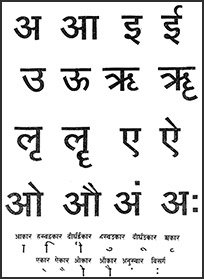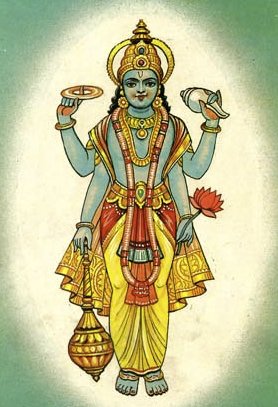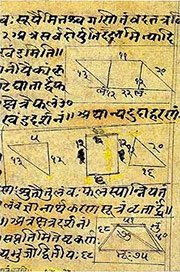Antya, Antyā, Āntya, Amtya: 19 definitions
Introduction:
Antya means something in Hinduism, Sanskrit, Marathi. If you want to know the exact meaning, history, etymology or English translation of this term then check out the descriptions on this page. Add your comment or reference to a book if you want to contribute to this summary article.
In Hinduism
Purana and Itihasa (epic history)
Source: Wisdom Library: Varāha-purāṇaAntyā (अन्त्या).—Name of a river originating from Vindhya, a holy mountain (kulaparvata) in Bhārata, according to the Varāhapurāṇa chapter 85. There are settlements (janapada) where Āryas and Mlecchas dwell who drink water from these rivers.
Bhārata is a region south of Hemādri, once ruled over by Bharata (son of Ṛṣabha), whose ancestral lineage can be traced back to Svāyambhuva Manu, who was created by Brahmā, who was in turn created by Nārāyaṇa, the unknowable all-pervasive primordial being.
The Varāhapurāṇa is categorised as a Mahāpurāṇa, and was originally composed of 24,000 metrical verses, possibly originating from before the 10th century. It is composed of two parts and Sūta is the main narrator.
Source: Cologne Digital Sanskrit Dictionaries: The Purana IndexAntya (अन्त्य).—A son of Bhṛgu, and a deva.*
- * Brahmāṇḍa-purāṇa III. 1. 89.

The Purana (पुराण, purāṇas) refers to Sanskrit literature preserving ancient India’s vast cultural history, including historical legends, religious ceremonies, various arts and sciences. The eighteen mahapuranas total over 400,000 shlokas (metrical couplets) and date to at least several centuries BCE.
Vyakarana (Sanskrit grammar)
Source: Wikisource: A dictionary of Sanskrit grammar1) Antya (अन्त्य).—Final letter; अन्ते भवमन्त्यम् (ante bhavamantyam)
2) Antya.—Final consonant of each of the five groups of consonants which is a nasal अन्त्योनुनासिकः (antyonunāsikaḥ) R.T. 17.

Vyakarana (व्याकरण, vyākaraṇa) refers to Sanskrit grammar and represents one of the six additional sciences (vedanga) to be studied along with the Vedas. Vyakarana concerns itself with the rules of Sanskrit grammar and linguistic analysis in order to establish the correct context of words and sentences.
Vaishnavism (Vaishava dharma)
Source: Pure Bhakti: Bhagavad-gita (4th edition)Antya (अन्त्य) refers to “last”. (cf. Glossary page from Śrīmad-Bhagavad-Gītā).

Vaishnava (वैष्णव, vaiṣṇava) or vaishnavism (vaiṣṇavism) represents a tradition of Hinduism worshipping Vishnu as the supreme Lord. Similar to the Shaktism and Shaivism traditions, Vaishnavism also developed as an individual movement, famous for its exposition of the dashavatara (‘ten avatars of Vishnu’).
Kavya (poetry)
Source: Brill: Śaivism and the Tantric Traditions (kavya)Antya (अन्त्य) refers to the “final (sacrifice)”, according to Kālidāsa’s Raghuvaṃśa verse 8.26.—Accordingly: “When he heard that his father had laid off his body, Raghu’s son shed tears for a long time, and then performed the final (antya) sacrifice of that Indra of the earth together with the chaplain”.

Kavya (काव्य, kavya) refers to Sanskrit poetry, a popular ancient Indian tradition of literature. There have been many Sanskrit poets over the ages, hailing from ancient India and beyond. This topic includes mahakavya, or ‘epic poetry’ and natya, or ‘dramatic poetry’.
Ganitashastra (Mathematics and Algebra)
Source: archive.org: Hindu Mathematics1) Antya (अन्त्य) refers to a “quadrillion” (1,000,000,000,000,000) in various lists of numeral denominations, according to gaṇita (“science of calculation”) and Gaṇita-śāstra, ancient Indian mathematics and astronomy.—We can definitely say that from the very earliest known times, ten has formed the basis of numeration in India. While the Greeks had no terminology for denominations above the myriad (104), and the Romans above the milk (103), the ancient Hindus dealt freely with no less than eighteen denominations [e.g., antya]. Cf. Yajurveda-saṃhitā (Vājasanyī) XVII.2; Taittirīya-saṃhitā IV.40.11, VII.2.20.1; Maitrāyaṇī-saṃhitā II.8.14; Kāṭhaka-saṃhitā XVII.10, XXXIX.6; Anuyogadvāra-sūtra 142; Āryabhaṭīya II.2; Triśatikā R.2-3; Gaṇitasārasaṃgraha I.63-68.
2) Antya (अन्त्य) or Antyamūla refers to the “second (root)”, according to the principles of Bījagaṇita (“algebra” or ‘science of calculation’).—According to Pṛthūdakasvāmī (860) in his commentary on the Brāhmasphuṭasiddhānta by Brahmagupta (628): “Here are stated for ordinary use the terms which are well known to people. [...] The root which results, after those operations have been performed, is called by the name the greater root (jyeṣṭhapada) or the second root (anya-mūla [=antyamūla?])”.
Synonyms: Jyeṣṭha.

Ganitashastra (शिल्पशास्त्र, gaṇitaśāstra) refers to the ancient Indian science of mathematics, algebra, number theory, arithmetic, etc. Closely allied with astronomy, both were commonly taught and studied in universities, even since the 1st millennium BCE. Ganita-shastra also includes ritualistic math-books such as the Shulba-sutras.
Languages of India and abroad
Marathi-English dictionary
Source: DDSA: The Molesworth Marathi and English Dictionaryantya (अंत्य).—a (S) Relating to the end or conclusion; last, latter, final, ultimate.
--- OR ---
antya (अंत्य).—n S A thousand billions.
Source: DDSA: The Aryabhusan school dictionary, Marathi-Englishantya (अंत्य).—n Final, latter. n A thousand bil- lions.
Marathi is an Indo-European language having over 70 million native speakers people in (predominantly) Maharashtra India. Marathi, like many other Indo-Aryan languages, evolved from early forms of Prakrit, which itself is a subset of Sanskrit, one of the most ancient languages of the world.
Sanskrit dictionary
Source: DDSA: The practical Sanskrit-English dictionaryAntya (अन्त्य).—a. [ante bhavati vasati &c., antāya hitaḥ; anta-yat]
1) Last, final (as a letter, word &c.); last (in time, order or place) P.I.1.47; as ह (ha) of letters, Revatī of asterisms, Mīna of the zodiacal signs. &c.; अन्त्ये वयसि (antye vayasi) in old age R.9.79; अन्त्यं ऋणम् (antyaṃ ṛṇam) R.1.71 last debt; °मण्डनम् (maṇḍanam) 8.71 last funeral decoration, Kumārasambhava 4.22.
2) Immediately following (in comp.); अष्टम° (aṣṭama°) ninth.
3) perishable, transitory; देहाद्यपार्थमसदन्यमभिज्ञमात्रं (dehādyapārthamasadanyamabhijñamātraṃ) (vindeta) Bhāgavata 12.8.44.
4) Lowest (in rank, degree or position), undermost, worst, inferior, base, vile, wretched; °अवस्थां गतः (avasthāṃ gataḥ) Pañcatantra (Bombay) 4.11 reduced to the worst plight; अन्त्यासु दशासु (antyāsu daśāsu) Pañcatantra (Bombay) 1.336 at perilous (critical) times; belonging to the lowest caste; चण्डाल °स्त्रियः (caṇḍāla °striyaḥ)Manusmṛti 11.175; °स्त्रीनिषेविणः (strīniṣeviṇaḥ) 12.59; अन्त्यादपि वरं रत्नं स्त्रीरत्नं दुष्कुलादपि (antyādapi varaṃ ratnaṃ strīratnaṃ duṣkulādapi); शूद्राश्च सन्तः शूद्राणामन्त्यानामन्त्ययोनयः (śūdrāśca santaḥ śūdrāṇāmantyānāmantyayonayaḥ) (sākṣyaṃ kuryuḥ) 8.68, 3.9; 4.79; Y.1.148, 2.294.
-ntyaḥ 1 A man of the lowest caste; see above.
2) Name of a plant (mustā Mar. nāgara- mothā) (f. also) (the roots of which are prescribed for colic).
3) The last syllable of a word.
4) The last lunar month i. e. Fālguna.
5) A Mlechcha, foreigner, barbarian. अन्त्येषु स विनिक्षिप्य पुत्रान् यदुपुरोगमान् (antyeṣu sa vinikṣipya putrān yadupurogamān) Mahābhārata (Bombay) 1.86.12.
6) (In Vaiśeṣika Phil.) A name for the category विशेष (viśeṣa); अन्त्यो नित्यद्रव्यवृत्तिर्विशेषः परिकीर्तितः (antyo nityadravyavṛttirviśeṣaḥ parikīrtitaḥ) Bhāṣā P.
-ntyā 1 A technical name for त्रिज्या (trijyā) in astronomy.
2) A woman of the lowest tribe.
-ntyam 1 A measure of number; 1 billions (1,,,,.)
2) The 12th sign of the zodiac.
3) The last member or term of a progression (series), the last figure; स्थाप्योन्तवर्गो द्विगुणान्त्यनिघ्नः (sthāpyontavargo dviguṇāntyanighnaḥ) Līlā.
--- OR ---
Āntya (आन्त्य).—Ved. One who finishes.
Derivable forms: āntyaḥ (आन्त्यः).
Source: Cologne Digital Sanskrit Dictionaries: Shabda-Sagara Sanskrit-English DictionaryAntya (अन्त्य).—mfn.
(-ntyaḥ-ntyā-ntyaṃ) 1. Last, ultimate. 2. Inferior, low. m.
(-ntyaḥ) 1. A man of low caste. 2. A fragrant grass, (Cyperus rotundus.) See sustā. n.
(-ntyaṃ) A measure of number, two Sagaras, a very large number. E. anta, and yat aff.
Source: Cologne Digital Sanskrit Dictionaries: Benfey Sanskrit-English DictionaryAntya (अन्त्य).—i. e. anta + ya. I. adj., f. yā. 1. Last, [Mānavadharmaśāstra] 11, 213. With daśā, State of extremity, [Pañcatantra] 70, 5. 2. Lowest, [Pañcatantra] iv. [distich] 76. Of a very low class, [Mānavadharmaśāstra] 12, 59. Ii. m. 1. A Cāṇḍāla, [Mānavadharmaśāstra] 2, 238. 2. One of a barbarous nation, [Mānavadharmaśāstra] 3, 9.
Source: Cologne Digital Sanskrit Dictionaries: Cappeller Sanskrit-English DictionaryAntya (अन्त्य).—[adjective] ultimate, last (in sp., t., and order).
Source: Cologne Digital Sanskrit Dictionaries: Monier-Williams Sanskrit-English Dictionary1) Antya (अन्त्य):—[from anta] a etc. See antika, p.45.
2) [from antika] b mfn. last in place, in time, or in order
3) [v.s. ...] ifc. immediately following e.g. aṣṭamāntya, the ninth
4) [v.s. ...] lowest in place or condition, undermost, inferior, belonging to the lowest caste
5) [v.s. ...] m. the plant Cyperus Hexastachyus Communis
6) [v.s. ...] n. the number 1000 billions
7) [v.s. ...] the twelfth sign of the zodiac
8) [v.s. ...] the last member of a mathematical series.
9) Āntya (आन्त्य):—[from ānta] m. one who finishes, personified as Bhauvana, [Vājasaneyi-saṃhitā; Taittirīya-saṃhitā]
Source: Cologne Digital Sanskrit Dictionaries: Goldstücker Sanskrit-English DictionaryAntya (अन्त्य):—1. m. f. n.
(-ntyaḥ-ntyā-ntyam) 1) Last, ultimate. (In the Vaiśeṣika philos., antyo viśeṣaḥ is called ‘the ultimate degree of particularity or divisibility, which is the condition of eternal substances only’, viz. the condition of simple, non-compound substances, of atoms, since there is an end of discrimination when this last degree of elementary existence has been arrived at; compare also antyāvasthiti.)
2) Final (as the letter of a word).
3) Nearest, e. g. navāntya nearest to nine i. e. ten. Comp. antima and the words named s. v. antika.
4) Inferior, lowest, belonging to the lowest tribe (see the following meanings). [[tatpurusha compound] compounds—not [karmadharaya compound]—the latter part of which is antya have the udātta accent on the first syllable.] 2. m.
(-ntyaḥ) 1) A man of the lowest tribe. See antyaja.
2) A Mlechchha or foreigner. See antyaja.
3) (In Astronomy.) The twelfth or last lunar month, called Phālguna.
4) A fragrant grass (Cyperus rotundus). See mustā.
5) m. pl.
(-ntyāḥ) The name of a people or country; read also andhāḥ or andhrāḥ or adhyāḥ. 3. f.
(-ntyā) 1) A woman of the lowest tribe. See antyaja.
2) (In Astronomy) thus defined: ahorātravṛttavyāsārdhaṃ trijyātulyairaṅkairaṅkyate tāvattrijyātulyaṃ bhavati tairaṅkairyāvatkujyā gaṇyate tāvaccarajyātulyā bhavati . atha carajyayā trijyā yutonā antyāsaṃjñā bhavati (Siddhāntaśir. Gaṇitādhy. ed. Calc. p. 128). 4. n.
(-ntyam) 1) (In Arithm.) A measure of number, a thousand billions (1000,000,000,000,000).
2) (In Astronomy.) The last or twelfth sign (lagna) of the Zodiac, the Pisces or mīnarāśi. See antyabha.
3) (In Astronomy.) The last or twenty seventh mansion in the circumference of the moon’s periodical revolution, the Nakshatra Revatī, the Yoga star of which is Piscium. See antyabha. E. anta, taddh. aff. yat.
Source: Cologne Digital Sanskrit Dictionaries: Yates Sanskrit-English DictionaryAntya (अन्त्य):—[(ntyaḥ-ntyā-ntyaṃ) a.] Last.
Source: DDSA: Paia-sadda-mahannavo; a comprehensive Prakrit Hindi dictionary (S)Antya (अन्त्य) in the Sanskrit language is related to the Prakrit words: Aṃta, Āṃta.
[Sanskrit to German]
Sanskrit, also spelled संस्कृतम् (saṃskṛtam), is an ancient language of India commonly seen as the grandmother of the Indo-European language family (even English!). Closely allied with Prakrit and Pali, Sanskrit is more exhaustive in both grammar and terms and has the most extensive collection of literature in the world, greatly surpassing its sister-languages Greek and Latin.
Kannada-English dictionary
Source: Alar: Kannada-English corpusAṃtya (ಅಂತ್ಯ):—
1) [adjective] being at the end; final; last.
2) [adjective] occupying the lowest position; having the lowest rank.
--- OR ---
Aṃtya (ಅಂತ್ಯ):—
1) [noun] the last, final point of anything; end.
2) [noun] a member of any lowest caste.
3) [noun] a foreigner to India.
4) [noun] cessation of life; death.
5) [noun] one thousand billion.
6) [noun] destruction of the world; universal destruction.
Kannada is a Dravidian language (as opposed to the Indo-European language family) mainly spoken in the southwestern region of India.
See also (Relevant definitions)
Starts with (+51): Amtyadarshana, Amtyagaurava, Amtyagolisu, Amtyagollu, Amtyajanma, Amtyajata, Amtyaje, Amtyakala, Amtyakriye, Amtyakshara, Amtyaprasa, Amtyarambhi, Amtyasamskara, Amtyayamaka, Antyabha, Antyabhigamana, Antyadarana, Antyadhana, Antyadi, Antyadyujiva.
Ends with (+25): Adantya, Adaphantya, Ahantya, Aikantya, Akashanantya, Anaikantya, Anantya, Anekaksharantya, Arhantya, Ashamtya, Avantya, Bahvaksharantya, Bhavadantya, Bhrajobhradantya, Bhrantya, Buddhimandya, Dantya, Dinadalantya, Ekantya, Ghantya.
Full-text (+74): Antyajanman, Antyaja, Antyakarman, Antyavarna, Antyeshti, Antyabha, Antyayoni, Antyayana, Anta, Antyamula, Antyavipula, Antyapada, Antyayuga, Antyajati, Antyakriya, Antyahuti, Antyajatiya, Amtya, Antyadhana, Antyaka.
Relevant text
Search found 33 books and stories containing Antya, Amtya, Aṃtya, Antyā, Āntya; (plurals include: Antyas, Amtyas, Aṃtyas, Antyās, Āntyas). You can also click to the full overview containing English textual excerpts. Below are direct links for the most relevant articles:
Yajnavalkya-smriti (Vyavaharadhyaya)—Critical study (by Kalita Nabanita)
Chapter 3.2b - Untouchability < [Chapter 3 - The Social Aspect Depicted in the Vyavahārādhyāya]
Chapter 5.22 - Laws Relating to Adultery with Women (strīsaṃgrahaṇa) < [Chapter 5 - Vyavahārādhyāya and the Modern Indian Laws]
Manusmriti with the Commentary of Medhatithi (by Ganganatha Jha)
Verse 4.79 < [Section IX - Personal Cleanliness]
Verse 3.9 < [Section III - Marriageable Girls]
Verse 11.197 < [Section XXII - Expiation for Brāhmaṇas acquiring Property by Improper Means]
Tattvartha Sutra (with commentary) (by Vijay K. Jain)
Verse 2.44 - Means of enjoyment (upabhoga) < [Chapter 2 - Category of the Living]
Vaisheshika-sutra with Commentary (by Nandalal Sinha)
Sūtra 1.2.6 (Final Species excluded) < [Chapter 2 - Of Genus and Species]
Padarthadharmasamgraha and Nyayakandali (by Ganganatha Jha)
Text 156: On Viśeṣa < [Chapter 8 - On Viśeṣa]
Shrimad Bhagavad-gita (by Narayana Gosvami)
Verse 4.28 < [Chapter 4 - Jñāna-Yoga (Yoga through Transcendental Knowledge)]
Verse 9.30 < [Chapter 9 - Rāja-guhya-yoga (Yoga through the most Confidential Knowledge)]
Verse 14.26 < [Chapter 14 - Guṇa-traya-vibhāga-yoga]